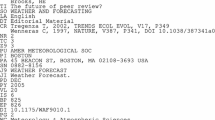Abstract
In this paper we investigate the position of a review network within a research specialty; the network of scholars who write reviews of their colleagues’ work. This is one of the voluntary activities that researchers perform as a prerequisite for the functioning of the invisible college. We compare this network to other networks within the specialty, and this allows us to distinguish various roles: stars, influentials, members, reviewers and juniors. As scholars are characterized by different role-configurations, the invisible college becomes stratified. We discuss the implications for the development of a referee factor and review factor, norms for refereeing and reviewing, and the development of systems-based research evaluations.
Similar content being viewed by others
References
Ahlgren, P., Jarneving, B., Rousseau, R. (2003), Requirement for a co-citation similarity measure, with special reference to Pearson’s Correlation coefficient. JASIST, 54(6): 550–560.
Borgatti, S. P. (2002), NetDraw: Graph Visualization Software. Harvard: Analytic Technologies.
Borgatti, S. P., Everett, M., Freeman, L. (2002), UCINET 6 for Windows. Harvard Analytic Technologies
Crane, D. (1972), Invisible Colleges: Diffusion of Knowledge in Scientific Communities. Chicago, University Press.
Cronin, B. (1995), The Scholar’s Courtesy: The Role of Acknowledgements in the Primary Communication Process. Los Angeles, CA: Taylor Graham Publishing.
Cronin, B. (2001), Acknowledgement trends in the research literature of information science, Journal of Documentation, 57(3): 427–433.
Davis, C. H., Cronin, B. (1993), Acknowledgments and intellectual indebtedness: A bibliometric conjecture. JASIST, 44(10): 590–592.
Garvey, W. D., Griffith, B. C. (1968), Informal channels of information in the behavioural sciences: Their relevance in the structuring of formal or bibliographic communication. In: E. B. Montgomery (Ed.), The Foundations of Access to Knowledge. Syracuse: Syracuse University, pp. 129–146.
Glänzel, W., Moed, H. F. (2002), Journal impact measures in bibliometric research. Scientometrics, 53(2): 171–194.
Griffith, B. C. (1990), Understanding science: Studies of communication and information. In: C. L. Borgman (Ed.), Scholarly Communication and Bibliometrics. Newbury Park, CA: Sage, pp. 31–45.
Laudel, G. (2001), What do we measure by co-authorships? In: M. Davis, C. S. Wilson (Eds), Proceedings of the 8th International Conference on Scientometrics and Informetrics. Sydney, Australia: Bibliometrics & Informetrics Research Group, pp. 369–384.
Leydesdorff, L. (2005), Similarity measures, author co-citation analysis, and information theory. Journal of the American Society for Information Science and Technology, 56(7): 769–772.
Mathematical Reviews Database: Guide for Reviewers. (2006). Retrieved November 15, 2006 from http://www.ams.org /authors/guide-reviewers.html
Melin, G., Persson, O. (1996), Studying research collaboration using co-authorships. Scientometrics, 36: 363–377.
Newman, M. (2004), Coauthorship networks and patterns of scientific collaboration, Proceedings of the National Academy of Sciences, 101: 5200–5205.
Price, D. de Solla (1986), Little Science, Big Science….and Beyond. New York: Columbia University Press
Rousseau, R., Biologist Rory Wilson proposes a referee factor. ISSI Newsletter, 2(2): 1–2.
Singh, S. (1998). Fermat’s Enigma. Toronto: Penguin Books Ltd.
Small, H. (2005), Tracking and predicting growth areas in science. In: P. Ingwersen & B. Larson (Eds) Proceedings of the 10th International Conference on Scientometrics and Informetrics. Stockholm, Sweden: Karolinska University Press, pp. 13–23.
White, H. D., Griffith, B. C. (1981), Author co-citation: A literature measure of intellectual structure. JASIS, 32(3): 163–172.
White, H. D. (2001), Authors as citers over time. Journal of the American Society for Information Science and Technology, 52(2): 87–108.
White, H. D., Wellman, B., Nazer, N. (2004), Does citation reflect social structure? Longitudinal evidence from the “Globenet” interdisciplinary research group. Journal of the American Society for Information Science and Technology, 55(2): 111–126.
Wilson, R., Lancaster, J. (2006), ’Referee factor’ would reward a vital contribution. Nature, 441: 812.
Zuccala, A. (2006), Modeling the invisible college. JASIST, 57(2): 152–168.
Author information
Authors and Affiliations
Corresponding author
Rights and permissions
About this article
Cite this article
Zuccala, A., Van Den Besselaar, P. Mapping review networks: Exploring research community roles and contributions. Scientometrics 81, 111–122 (2009). https://doi.org/10.1007/s11192-008-2136-2
Received:
Published:
Issue Date:
DOI: https://doi.org/10.1007/s11192-008-2136-2




